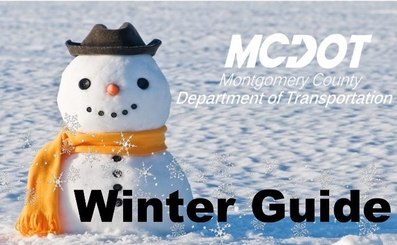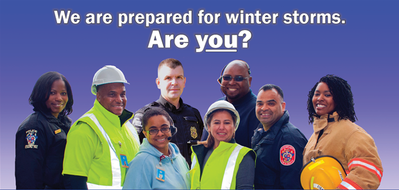
 Clearing Sidewalks - If You Own Property, It's Your Responsibility
Clearing sidewalks within
24 hours after the end of a snowstorm is a civic responsibility that keeps our
communities and neighbors safe – and it’s the law. Property owners are required to clear sidewalks in front of, and alongside,
their properties. Make sure to clear walks wide
enough to accommodate wheelchairs and walkers. If your neighbor is elderly
or disabled, you can assist them by clearing their sidewalks and checking on them
during storms.
MCDOT will be doing its
part by clearing ice and snow from 300 miles of County-owned sidewalks and more
than 20 miles of major trails. Transit Services will also be clearing all bus
shelters and stops that serve 15 or more daily passengers.
Residents who wish to
report an unshoveled sidewalk can do so online,
or by calling 311 (240-777-0311 outside County). Reports must include an exact
address.

 Who Clears the Snow?
MCDOT is responsible for
clearing snow from 5,200 lane miles of County-maintained roads – but this
doesn’t include every road in the County. All State-maintained, numbered roads
in the County are cleared by the Maryland State Highway Administration. Other
departments, outside agencies and governmental jurisdictions also have
responsibility for plowing. They include Montgomery County Public Schools; The
Maryland-National Capital Park & Planning Commission; the Washington Metropolitan
Area Transit Authority (Metro); municipalities and homeowner’s associations.
Commercial parking lot owners plow their own properties and are prohibited from
pushing snow into roadways.
Find out who plows your
street by visiting the County’s Snow Portal.
When Snow or Ice is Predicted, MCDOT Springs into Action
County
snow fighters begin their job well before snow is predicted to fall. Highway
Services staff track weather reports days in advance to determine if the MCDOT
Storm Operations Center should be activated and when to do so. Snow plow crews
and truck mechanics at each depot are called to report in advance of a storm
and may begin pretreating major roads with salt brine, a solution of salt and
water, depending on conditions. Salt brine prevents ice and frost from forming
on pavement and makes snow removal easier. The use of salt brine also reduces
the amount of salt needed to treat pavement following a snowfall.
At
the start of a storm, crews patrol to monitor road conditions. When snow or
freezing precipitation begins to cover the roads, crews spread salt on
emergency and primary neighborhood roads. Throughout a snow storm, the County
spreads abrasives on hills, at intersections, and on roads around schools.
Plows are ineffective until snowfall accumulations reach three inches. At that
point, Highway Services starts plowing operations and continues salting,
focusing on main roads. During the snowfall, about 1,000 lane miles of main
roads are kept in “bare pavement” condition. This ensures that every County
resident is within one-half mile of a cleared road and can be reached by
emergency equipment. It also means that when residents leave their
neighborhoods, the main roads are ready to handle traffic.
Once
the snow stops falling and major roads are clear, crews turn their attention to
removing snow from more than 4,300 miles of neighborhood streets. Their goal is
to make these streets passable – not clear them to bare pavement. Crews eat and
sleep at the depots and do not go home until snow removal operations are
completed.
MCDOT
has 200 Highway Services employees and 175 pieces of equipment to handle snow
operations. If more resources are needed, contractors can be called upon
immediately to provide hundreds of pieces of additional equipment and plow
operators.

During winter storm
season, learn what you can do to keep you and your family safe:
Before a storm
- Ensure that you have
enough food, water, medication (if needed) and batteries to last two to three
days.
- Check portable radio,
smoke detectors and flashlights to ensure they are working and that the
batteries are fresh. Fully charge your cell phone.
- Check heating equipment.
If you use propane or fuel oil, make sure that levels are near full.
- Have a snow shovel ready.
- Run necessary errands.
Don't wait until the storm strikes.
- Ensure that your vehicle
is properly winterized and that snow tires and/or chains are ready. Also, keep
a blanket, snow shovel, sand or kitty litter and flares in the vehicle. Fill
the gas tank.
- Park cars off-road,
especially on narrow streets, to help snow plow operators safely clear streets
from curb-to-curb. Where off-road parking is not available, work with neighbors
to park cars on one side of the street.
- Don't park on snow
emergency routes during a declared snow emergency or your car may be towed.
Major roads must be kept clear for emergency vehicles. Snow emergency routes
are designated by red and white signs.
- Check with neighbors who
may require special assistance to see if they need help in stocking up on
supplies or medications, and call them during the storm.
During a Storm
- Stay indoors. Only travel
when absolutely necessary. Give snow plows a chance to clear the roads. If
travel conditions become difficult, seek refuge and remain there until the
storm has passed.
- If you must go out, leave
your car at home and take transit.
- When going outside,
ensure that you have proper clothing to protect you from the elements. A heavy
coat, gloves, boots and a hat are a must.
- If driving during the
storm is unavoidable, put together a supply kit for the car that includes a
flashlight with extra batteries, flares, blankets or sleeping bags, dry clothing,
snacks and water, a small shovel, jumper cables, first aid kit and necessary
medications.
- Use extra caution on the
road by leaving at least 10 feet between you and other vehicles.
- Residents concerned about
the safety and well-being of children, elderly individuals or adults with
disabilities should call the County’s Crisis Center at 240-777-4000.
After a Storm
- Remove snow and ice from
doors, decks and gutters. If heavy snow accumulates on roofs do not attempt to
use a ladder or climb onto the roof to remove it. Call a contractor instead.
- Watch for downed power
lines. If lines are down, do not touch wires or anything that the wires are
touching. Contact your local utility. If wires are sparking, call 911.
- Try to give snow plow
operators a chance to remove snow or ice off highways and residential streets
before venturing out.
- If snow has covered fire
hydrants, help to remove it so firefighters can easily locate them in the event
of an emergency.

For Pedestrian and Drivers
Pedestrians
- Walk safely by obeying all traffic signs and signals.
- Be aware that cars may not be able to stop as quickly on
snow and ice. Do NOT walk in the roadway and watch for icy and slick spots.
- Do not assume vehicles can see you. Wear reflective
clothing.
- Wear shoes or boots with non-slip soles.
Drivers
- Stay alert for pedestrians walking in the roadways,
especially when visibility is low.
- Drive slowly! Stopping distances increase in poor
weather conditions.
- Be especially alert for pedestrians at intersections
where snow mounds may limit sight lines.
For Snow Shoveling
Dress appropriately for winter weather. Ears, hands and feet need extra protection in frigid temperatures.
Shovel as the snow falls, if you can. That way, there is less to remove. It’s also easier to remove fresh snow that has not hardened or turned to ice.
Put less pressure on your back. Lift with legs bent to avoid injury and try pushing the snow instead of lifting it.
Pace yourself and take it slow. Shoveling can raise blood pressure and heart rate dramatically.
Don't work to the point of exhaustion. Take it easy and take breaks. If you run out of breath or feel tightness in your chest, stop immediately.
More Tips For...
Extreme Cold
Fires In The Home
Ice & Cold Weather
Avoiding Winter Fires in the Home
Staying Active in Cold Weather
20 Ways to Stay Warm (and Safe)
Car Checklist
Winter Health
Water Meters
Winter Heating
Winterizing Your Home
Fire/Carbon Monoxide
Fire Extinguishers



|